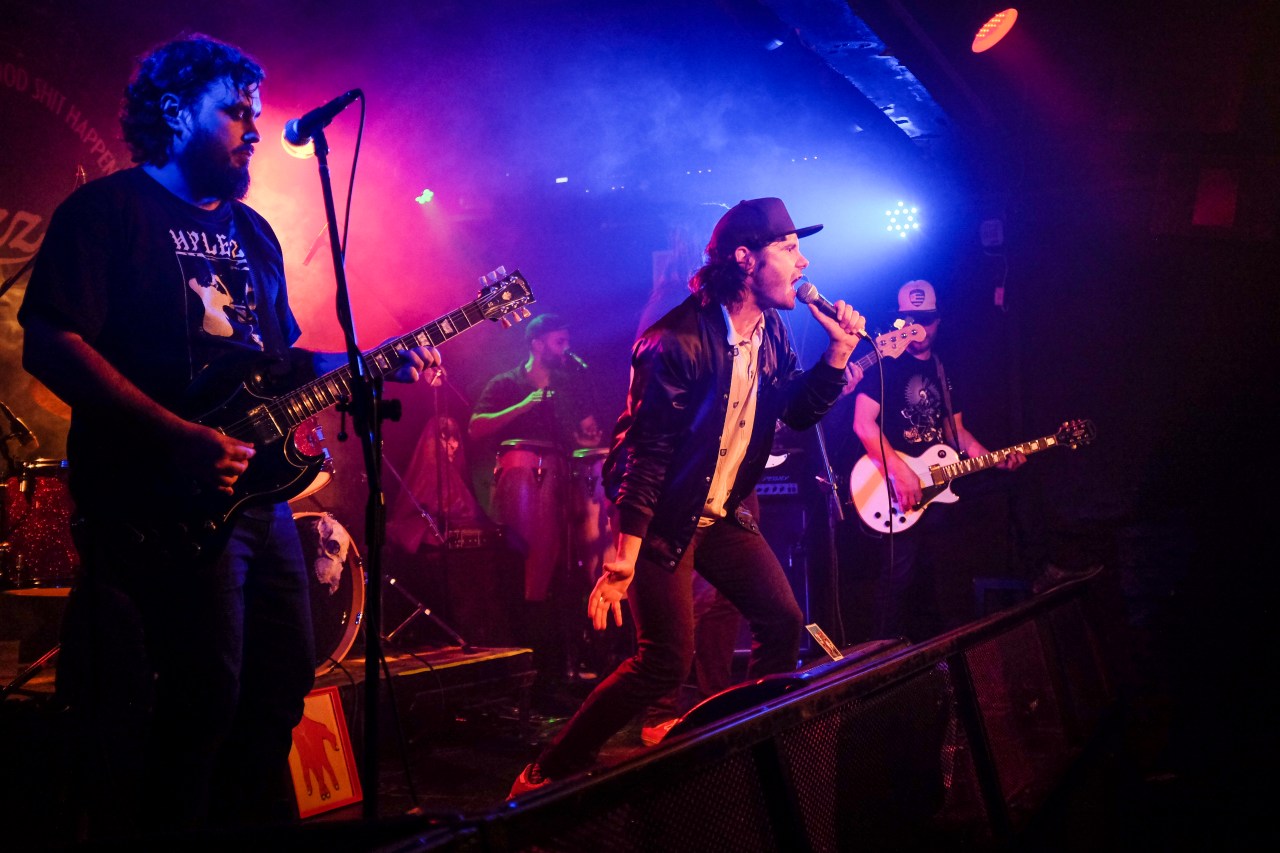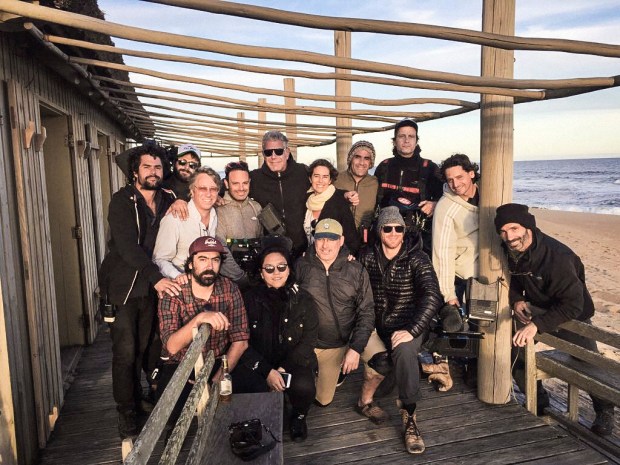Producer Helen Cho talks with episode director Steve Rivo, chef Ignacio “Nacho” Mattos, and musician Fermín Solana (of Hablan por la Espalda) about music, memories, and cooking with Nacho’s abuela.
Helen Cho: Steve, this was your first Parts Unknown shoot. What was it like being a newcomer on the crew?
Steve Rivo: I’ve been a fan of the show for years, so it was very exciting for me to be asked to direct. I was immediately struck by how great everyone on the Parts Unknown team is at their job, from the New York–based production team to the field crew to the folks that assemble all the gear we bring on the shoot. At this point, 11 seasons in, everyone knows exactly what to do. Since the pre-production period is pretty short, I had to dive right in, and it was challenging to learn all the systems and shorthand everyone on the show has developed. But everyone was generous with their time and advice, and I wasn’t shy about asking questions.
Cho: How did you approach this episode differently from other shows you’ve worked on?
Rivo: I spent a lot of time watching previous episodes of Parts Unknown and taking notes. Every episode is a little bit different—all the directors have unique styles—but I was looking for commonalities—of structure, of content presentation, of thematic weaving. The obvious common factor in every episode is Bourdain himself, and since the show is his journey and his point of view, I was looking for ways to set things up that would most successfully allow him to be himself and do what he’s great at doing.
Cho: What stuck out for you from the shoot?
Rivo: One thing was the scout, which was a four-day period before the shoot began. I was glad to hear we were budgeted to fly to Uruguay ahead of the crew but hadn’t realized that entailed going to every single restaurant, bar, and potential shooting location. We sprinted around the country like crazy people, scouting locations, meeting everyone, and eating and drinking everything in sight. It was exhausting, but as soon as we finished scouting, the shoot began, which was more like a marathon.
Also, shooting in Santa Lucía with [chef and restaurateur] Ignacio Mattos’ family was memorable. It’s a privilege to see where people come from and how they grew up, and everyone welcomed us so warmly.

Cho: Nacho, what was it like going back to your hometown with Tony and a camera crew?
Ignacio Mattos: It was a lot. We were only in Santa Lucía for a day, so trying to catch up with everyone was difficult. There were lots of emotions to process—seeing everyone age, especially my grandmother. That said, we had a lot of fun. It was refreshing to see how much intuition goes into her cooking. I thought I would see her use a measuring cup at least once, but she never did. I like to think that I lean on my senses, but after seeing her, maybe I’m actually a little stiff in the kitchen.
Overall, it was great to be able to spend the time with Tony and check out parts of the country he hadn’t been able to explore before and discuss Uruguayan identity and idiosyncrasies.
Cho: Your grandma’s tuco, or beef sauce, was so good. Can we share her recipe, or is it a family secret?
Mattos: I try to get that recipe from her, but there are always variables. It’s an oral history thing. There’s a very loose approach, but it always ends up pretty delicious.
Cho: You have three restaurants in New York City—Estela, Café Altro Paradiso, and Flora Bar—that aren’t specifically Uruguayan. Do you incorporate Uruguayan influences? Would you ever open a Uruguayan restaurant?
Mattos: Café Altro Paradiso in many ways reflects the things I grew up eating, like simple delicious pastas, pascualina, salads, grilled meats. Estela and Flora have Spanish roots, but Altro is definitely what’s close to home. Are they Uruguayan? Not necessarily, but that country’s cuisine is still being shaped. Maybe one day I’ll do an Uruguayan grill place. That would be fun.
Cho: Fermín and Tuka [also of Hablan por la Espalda] showed me an amazing clip of you stage-diving at one of their shows in Santa Lucia in 1996. Is that the first time you guys met? What was the hardcore scene in Montevideo like then?

Mattos: We had met before then, perhaps in 1994. This was at a big show we had organized, with a bunch of hardcore bands from Buenos Aires. It ended up being a festival with 600 people, which for the time was quite a lot.
Fermín Solana: Before us, there was little or no hardcore in Uruguay. There were elder DIY punk rockers, but they were more into the anarcho-punk genre. We and our friends at the time were pioneers in positive hardcore, straight edge, veganism, etc. We were influenced by Argentinian and Brazilian bands and U.S. legends like Minor Threat, Youth of Today, Sick of It All, Black Flag. Some Argentinian bands in the Buenos Aires hardcore scene, which was strong at the time, crossed the river and played in Montevideo, and those shows had a great impact on us. The crowd was mainly metalheads and old punks, so we came as the hardcore kids with our baggy pants, caps, sneakers, and skateboards.
Mattos: I had a zine, and I remember the American Mormons would bring hardcore records from the States. I’d have to listen to their spiel before I got my hands on the music. But it was totally worth it.
Cho: What was your zine about? Do you have a photo or copy of it?
Mattos: No, unfortunately, no photos or copies. It had interviews and info on bands.
Cho: What are you both listening to now?
Mattos: Alice Coltrane, Sun Ra, Lullatone [a wacky Japanese-American duo], 108 [hardcore Hare Krishnas], Kendrick Lamar, J Dilla, T-Model Ford, Chains of Strength, and—always—the Stones and the Replacements.
Solana: I listen to a lot of Jamaican music—dub, rocksteady, Trojan Records’ catalog, basically. That’s been the soundtrack to my life during the last five years. Lots of Augustus Pablo, Scientist, Lee “Scratch” Perry. I also listen to some British contemporary acts such as Sleaford Mods and King Krule. And often some Black Lips, from the U.S. My favorite Uruguayans are Los Nuevos Creyentes. I strongly suggest people look for them if they are into Spanish music. And also Uruguayan–New York resident Juan Wauters.
Cho: HPLE recently opened for Iggy Pop. What’s next, Fermín?
Solana: We just played at Montevideo Rock, a huge open-air festival with some of the most popular bands, and we are working on our next album, which we believe will be our best. Also planning to visit Brazil and Argentina during the next months. Opening for Iggy Pop came as a beautiful surprise for us, so we always keep our expectations high towards what may come next. We would really love to tour Europe, Mexico, and the United States. We only played in the U.S. once, at SXSW as part of a Uruguayan showcase.

Cho: When the crew arrived to film, you were in the process of reopening your restaurant, Futuro Refuerzos. How is it going?
Solana: We finally reopened on Dec. 18 at our new location in the most executive part of the city, World Trade Center Montevideo. We’ve been really busy and have been perfecting our refuerzos [sandwiches] every day in our immaculate new kitchen. It takes a lot of love and passion, since we make our own bread and try to keep every ingredient homemade. This new location is challenging, since we sell much more than we did at our old place, and being a business area, people have to rush. We have to keep our product pure and delicious but also work very fast.
Cho: Were there any scenes you wished you could have filmed but ran out of time?
Mattos: Su-bar, a classic cantina rooted in Spain. I also would have liked to check out La Pasiva, which is pretty much a chain similar to Howard Johnson’s or Vips in Spain. I used to go there a lot for fugazetas [pizzas] and chivitos [steak sandwiches]. They are well known for hungaras—these little sausages—and hot dogs wrapped in bacon. They make a proprietary white mustard you can’t get anywhere else. I must confess I used to steal it as a kid.
Rivo: Directors are greedy. We always want more time—for the prep, the shoot, the edit. It’s a perfectionist’s game. But my biggest regret was not filming in this amazing and beautifully neon-lit, 24-hour choripán [chorizo sandwich] joint called El Condor directly across from our hotel. We did manage to eat there more than once, however.
Solana: I’m sad we missed Futuro by a few weeks. I also would have loved to take you guys to support my football team [Nacional], but there was no competition at the time because of football violence. Next time!
This interview has been edited and condensed.